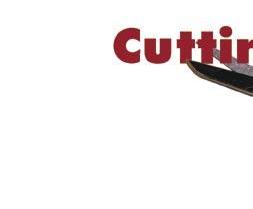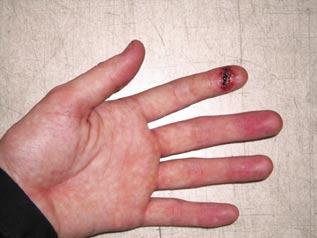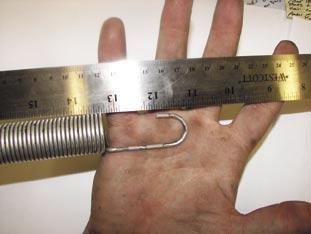
6 minute read
On the Cutting Edge
from MECH Fall 2007
On the Edge
By PR3 John Bradley
Advertisement
Many ideas, in hindsight, simply don’t turn out to be the best decisions. I recently proved that I’m no different than anyone else when my great idea turned into a nightmare.
I consider myself a good worker, well motivated, and I feel that I practice safety in everything that I do. I have been in the Navy for three years and ever since I can remember, I have heard ORM preached in every way. Yet, mishaps happen when you least expect it, and usually because of poor headwork.
The morning of my incident was like so many before; my shop had our hands full. Being a parachute rigger, I don’t have the jet work that the other shops face, but my shop more than makes up for it with our work on aircrew gear.
On this particular morning, I was doing a routine build-up on the flight gear for one of our new aircrew.

This work is relatively simple but a time-consuming process. We still had a lot of work to do and wanted to get this job done quickly so the lieutenant could start flying. I never dreamed doing something so simple could cause such a problem.
While putting in the tackings on a survival vest, I ran into a very thick piece of webbing. It almost was impossible to push the thick hook needle I was using through the material. Unfortunately, it was the smallest needle that we had. We have special tools to force a straight needle through thicker material but that step didn’t work. In fact, the straight needle is thicker than the hook needle!
I am a pretty resourceful person and tried different ways to get the tacking in, all to no avail. Finally, I decided to try and put a small hole in the webbing using a pair of small scissors that we have. It seemed like a simple enough task, but boy was I wrong. Just poking a hole through the material was a hard task to accomplish. While attempting to make a hole through the material, the scissors slipped. I luckily had sharpened the scissors just before starting work on the vest. Was that a good idea or what? When the scissors slipped off the webbing, one edge sliced right through the pad on my left index finger. My first thought was not an uncommon one, “Oops,” followed with a few choice words. My next thought was more on target: “Man, was that dumb,” followed with a few more words not fit to print. The blood now was flowing freely out of my finger. When it wouldn’t stop, I knew I was on my way to the emergency room. An hour later, I had five stitches in my finger and a week of limited duty. Because of my carelessness and the already thin manning in my shop, everyone else will have to work even harder to get our mounting workload done. I clearly can see NOW what I had done was wrong. Just like in any game, it’s easier to point out the problems after the clock ticks off. I learned a valuable lesson, and a thorough ORM review or even a quick dose of time-critical ORM would have pointed out how bad it could get when I used a non-standard tool for this simple function. I’m alive and ready to move forward in my career with one simple reminder of a bad decision.
Petty Officer Bradley works in the paraloft at VAQ-141.
The Day I Got Hooked
By AMAA Jonathon Swafford
Atypical day during workups is not vastly different than any other workday, but this time I left work at noon, in an ambulance, and was granted four days of convalescent leave.
The day began as usual: I came in, got into my coveralls, started pre-ops, did FOD walkdown, and went over the day’s pass down that included a list of tasks we needed to do. I started removing panels and helped my shipmates do some of their jobs. All of it was in a normal day’s work.
In the afternoon, one of our AM3s asked me to help him remove the tail bumper on one of our aircraft, and, since I was new in the shop, I was a prime candidate for odd jobs. He was fairly familiar with the procedure, having worked on the acceptance of seven jets in the past six months and all of them “up jets” after their first check flight. The pub simply says to “remove the tail bumper,” so we checked out the toolbox and other tools that were required to do the job and headed for the hangar bay.
Our job was to remove the tail-hook bumper spring that retracts the hook. It started off right, and everything was running smoothly. Any doubt I had about the safety of the evolution disintegrated. We were close to the end of the job; one of the last steps is to loosen the bolts that hold the spring to the jet. This spring is under some tension, and it is much easier to remove it if someone applies pressure in the opposite direction. By adding pressure, we thought we would decrease the chance of the bumper popping back and flying across the hangar bay, damaging something or injuring someone.
As I was holding onto the spring, the AM3 was loosening the bolt, when it came loose and popped back into my hand, hooked end first. At the time, I did not realize the hook had gone into the bottom of my ring finger, through the webbing, and through my pinkie finger, nearly coming out the side of my hand.
Luckily, the AM3 was able to remove the hook from the other side and got me into the shop for help as fast as he could. I was moved to maintenance control where paramedics showed up, bandaged my entire hand, and then rushed me to the ER.

I learned a few lessons from this evolution. First, you always need to look at the pubs for the job you are going to do. In this case, it just says “remove the tail hook bumper” with no particular instructions or cautions about how to relieve the tension on the spring. We knew from experience it would be under tension, but the amount of force was unexpected.
If you know a procedure raises safety questions, but no cautions are associated with it, you should send a recommended change to the safety officer. Since we had done quite a few acceptances, we knew what we were up against and could have submitted a change earlier. PPE isn’t required for this job, but it could have been had we submitted the change. Also, if you don’t feel safe about a procedure, you should speak up.
The last point is that we had lax conditions. We had looked at the pub and done this procedure many times, but this familiarity caused us to go through the motions instead of really briefing what might happen. Had I thought of these things, it could have saved me a ride to the hospital.
Airman Apprentice Swafford works in the line division at VAQ-141.










